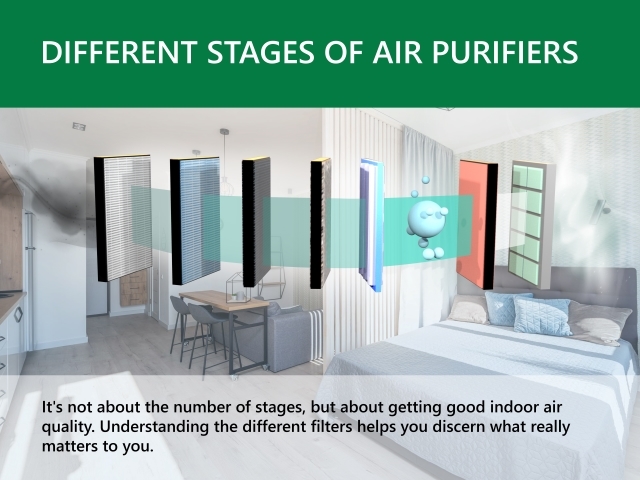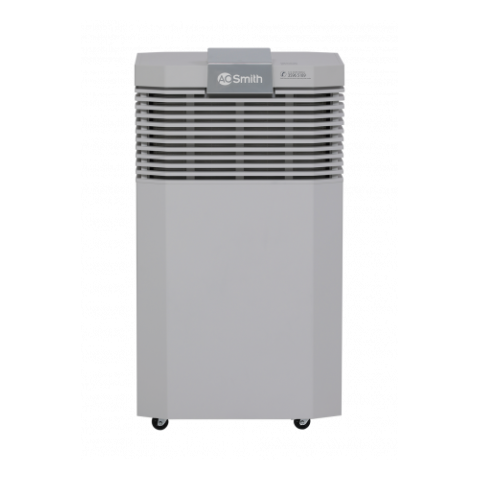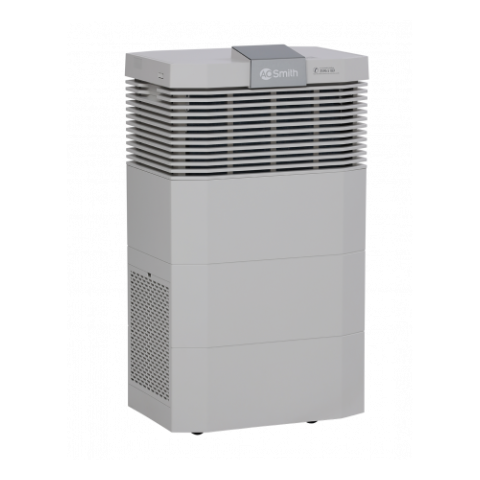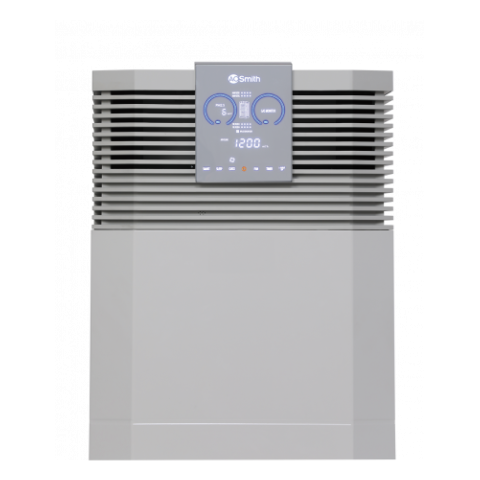Your home is the place where you should feel safe. However, indoor air pollutants such as dust, pet dander, pollen, and mold spores can be a major concern since these air pollutants cause several health problems like respiratory diseases and even cancer. In fact, indoor air pollution can be 2 to 5 times more harmful than outdoor air pollution because the air indoors is much more concentrated than the air outdoors. Air pollutants will always find their way inside via winds, pets, and humans no matter how well you clean your house. If you’re someone who spends time indoors most of the time, then this is quite alarming, right?
Due to the COVID-19 pandemic, many people are looking for ways to protect themselves from the risk of airborne transmission. For this reason, it’s no surprise that interest in air purifying technology has grown. According to the Environmental Protection Agency (EPA), portable air purifiers can be used to improve ventilation to protect against COVID-19. Air purifiers absorb polluted air and release clean air back out. However, not all air purifiers are created equal. It comes in all sorts of shapes, sizes, colors, energy-consumption levels and costs but they all aim to make the quality of air inside your home better. If you are someone who is completely new to the world of using air purifiers, it is important to know and understand first how each of these air purifiers work so you can buy the air purifier that best suit your needs and your lifestyle.
This article will help you figure out the differences between the common types or stages of air purifiers available in the market so you can understand their benefits and make wise decisions for cleaning the air in your living space.
HEPA
HEPA is an acronym for High Efficiency Particulate Air. It was originally developed during World War II to remove small radioactive dust particles from the air to protect soldiers’ respiratory systems. Today they are often used to remove the vast majority of irritating particles and air pollutants from hospitals to beauty salons to residential homes. It uses an advanced air filter to remove 99.97% of pollutants, such as pollen, mold, dust mites, and more particles that can’t be seen by the human eye. In simple words, for every 10,000 particles that are 0.3 microns in diameter, only three of them can pass through. Larger particles will immediately get caught so it cannot be able to pass through the openings of the fibers while smaller particles can be caught at even higher efficiency through interception, impaction or diffusion.
According to a study performed by NASA, HEPA filters were able to capture sub-micron particulate down up to 0.1 micron. They stated that diffusion of HEPA filters capture virtually 100% of particulates. The air is pumped back out into the room after it passes through the filter, then the purifier draws in more polluted air to purify. The more times air passes through the filter in an hour, the cleaner the air will become. Eventually, particulate matter (PM) levels will drop dramatically when most of the air in the room cycled through the purifier.
HEPA filters alone do not capture chemical gas, fumes, and cigarette smoke. This is why it is important to purchase a HEPA air purifier that includes an activated carbon filter to capture these allergens that the HEPA cannot. Although HEPA purifiers are the most effective purifiers for particulate matter, they also require a lot of upkeep. They collect so much dirt that they cannot be cleaned--they are disposed afterwards. Air will no longer be able to pass through the HEPA filter easily as it becomes full so a new filter will be needed to keep your unit in good shape. HEPA filter lifetime depends on number of hours of operation and how bad the air is, but typically they are designed to last at least a year. Products that claim recyclable HEPA filters are not really HEPA filters. If you live in a heavily polluted area then it means you will need to replace your filter more often. As a mechanical way of filtering air, HEPA purifiers use more energy than electronic air cleaners.
The HEPA term is abused a lot in the market. Some call their air purifiers “HEPA Type” or “HEPA Like”. Unlike True HEPA, these products usually have much lower efficiency. To ensure you are choosing a true HEPA purifier, make sure their filter has MERV17 or H13 or H14 HEPA rating. Whereas H10-H12 filters only trap 85-99.5% of particles with 0.1 microns in diameter while HEPA H13 and H14 trap 99.95% and 99.995% of such particles, respectively. It means the higher the grade, the better the filter. A higher medical grade HEPA is needed for a cleaner air.
Pre-Filters
Most air purifiers come with pre-filters as their first line of defense, capturing the largest or most obvious pollutants such as hair, fur, dust, pollen and even insects to prevent them from clogging the more superior filtering stages that deal with finer particles. Pre-filters help prolong the life of expensive HEPA filters, avoiding premature filter changes. The particles trapped by the pre-filters build up over time, so pre-filters will need regular replacement. Some air purifiers use pre-filters made of foam or nylon that can be washed and cleaned periodically. Others use disposable H7 filters that capture more dirt and protect the HEPA filters more than the washable types. A dirty pre-filter will reduce the air purifier’s airflow and therefore it's filtration efficiency. A dirty pre-filter will also cause the fan motor to work harder and use more energy to produce the same amount of airflow, causing an increase in electrical costs. Washable pre-filters should be cleaned regularly especially if your house is dusty or you have pets. Some air purifiers with disposable pre-filters have indicators to let you know when they need replacements.
Activated Carbon
If your concern is to remove odors and smells from your home, then an Activated Carbon Air Purifier is the right one for you. It is the only type of air purifier that is designed to eliminate odors, chemicals, fumes, smokes, and gases from the air. It has small molecular pores that chemically react to pollutants as they pass through the filter, causing the pollutants to bond with the carbon and become trapped. The process at work with a carbon filter is called adsorption.
This type of air purifier is particularly helpful to people with Multiple Chemical Sensitivity (MCS) because they absorb formaldehyde that can be found in carpet, wood paneling, and furniture upholstery. It makes the air much more breathable for babies, children, elderly and especially for those who suffer from asthma and allergies. However, Activated Carbon is expensive and does not deal effectively with airborne particles. It also has limitations in eliminating contaminants that are far away and not forced through the filter.
Zeolite
Zeolite is an inexpensive filter that is known for its ability to trap unwanted odor, chemicals and gases from the atmosphere to provide clean air. It is made up of aluminum, hydrated silicon compounds and oxygen. Zeolite is less expensive than activated carbon so some room air purifiers combine activated carbon with zeolite to reduce costs while still absorbing VOCs, ammonia and ammonium compound odors such as pet odors and urine.
Zeolite is now largely produced and used all over the world. It has many types; some are naturally occurring and others are man-made. Because of this, not all zeolite is useful or safe. Erionite Zeolite has similar genetics as Asbestos, a fiber that can cause a serious, chronic, non-cancerous respiratory disease. Although the two have different physical and chemical properties, Erionite Zeolite contains low levels of respirable silica which is hazardous to breathe in.
Generally, Zeolite as a filter stage is redundant as Activated Carbon already does the same job more effectively. However some air purifier manufacturers use Zeolite to reduce the cost of the machine.
UV
UV or Ultraviolet light comprises three sub-bands: UV-A, UV-B and UV-C. However, UV-C is the only band of UV light that does a very good job of killing pathogens’ core DNA, preventing these harmful microorganisms from multiplying. UV has a wide range of applications in medical setting, especially for antibacterial and antiviral disinfection. It is often used in sterile environments such as hospitals, kitchens, daycares, and labs.
UV light is produced by cold or hot cathode UV lamps. Hot cathode UV lamps require changes every 1-3 years. Cold cathode UV lamps have a longer lifespan, but they do not produce UV-C efficiently. For air purification, where efficiency is important because air is moving fast, hot cathode UV is more appropriate. Some UV lamps can have the harmful side effect of producing ozone, which can harm babies and young children. UV light can also damage the eyes and skin so it is important to take special care when using UV for air or surface disinfection.
Some air purifiers add a UV stage to deactivate potentially harmful viruses, bacteria, and pathogens from your home. It targets airborne microorganisms that go in the air purifier. The effectiveness of UV in an air purifier however is dependent upon the wattage of the light and the time of exposure to the light. UV takes some time to kill bacteria and virus so the faster the air is moving, the less effective it becomes. When you have a large room to purify, you will need faster clean air delivery rate (CADR), and UV becomes ineffective.
UV air purifiers won’t be able to clear the air of things like cigarette smoke, gases or chemical fumes. It also does not remove most allergens, dust, or solids in the air. For this reason, many people that use UV, start by filtering the air with HEPA and activated carbon before using the UV as a final stage of filtration. Since HEPA is already able to filter out bacteria and virus, the benefits of UV is marginal and redundant given its disadvantages.
Negative Ion
Ionic air purifiers or ionizers use ion generators that send out a continuous flow of negatively charged ions through a process known as a corona discharge. Negative ions are simply oxygen atoms that have gained an electron. They magnetically attract positive airborne particles such as dust and allergen particles in the air making the particles too heavy to remain airborne and fall to the floor. The particles can remain on surrounding surfaces in the room such as tables, windows or walls. Therefore, they have the ability to become loose and re-circulate themselves back into the air to contaminate it again.
Ionic purifiers operate extremely quietly because they have no fans or motors. They are effective at getting rid of second-hand smoke. They also don't need filter replacements and have lower upkeep costs. However, many studies have shown that they can produce ozone, formaldehyde and other VOCs as byproducts, re-polluting the air. These can cause lung damage, trigger asthma attacks, and can even lead to increased risk of death.
Ozone Generators
Ozone is a gas with a pungent smell. It is a strong oxidizer for organic matters including bacteria and viruses. At sufficiently high concentration, ozone can also eliminate cigarette smoke. According to US EPA, ozone is useful in killing microbes but it would have to exceed 5 to 10 times higher concentration than the limitations set by the US government in order for it to be effective in eliminating biological contaminants. For safe use, when an ozone air cleaner is used to sanitize a room, it should be free of occupants until the ozone dissipates, which may take between 30 minutes to 4 hours.
Health professionals have refuted the claims that ozone is safe and effective in controlling indoor air pollution since exposure to ozone may ignite asthma symptoms and a high enough level can even scar the lungs. Ozone air purifiers do not remove particles such as dust and pollen. Additionally, most studies show that many of the chemicals found in indoor environments take months or years for ozone to react, often leaving byproducts that are just as bad or even worse than the original chemicals. We therefore do not recommend ozone air cleaners for residential air purification. They are best used in a controlled environment in the commercial or industrial sector.
Electrostatic Precipitator
Electrostatic precipitation is an air purification technology that uses electrostatic force to control levels of airborne particles. It works like a magnet to trap dust, pet dander, mold and other allergens floating in the air. However, it does not address harmful gases at all so Volatile organic compounds (VOCs) and odors from sources such as tobacco smoke, wood smoke or pets will remain in the air. Basically, it functions almost the same way as an air ionizer except that the electrostatic precipitator has electrically charged plates to collect air pollutants. Once the particles in the air are completely charged, they pass over the collector plates. The air passes through one more filter for it to become clean air before it is finally released. The collector plates need to be cleaned every two weeks to once a month at minimum for it to remain effective.
The electrostatic air purifier must be run at a lower speed since the particles will not be charged and removed if air passes through too quickly. However, the air purifier's efficiency begins to decrease the minute particles begin collecting in the plates. Additionally, you must wait until the plates are completely dry to return it to the air purifier, which may take some time. It has marginal improvement compared to HEPA, but higher medical risks due to ozone and other byproducts.
Photocatalytic Oxidation
Photocatalytic Oxidation (PCO) has the ability to destroy microbes, Volatile Organic Compounds (VOCs), and Chemically Active Compounds (CACs) as small as 0.001 microns (nanometer) instead of just trapping them. Its process involves the combination of Ultraviolet light irradiation with a titanium dioxide coated filter to oxidize bacteria, viruses, mold and fungi. Oxidation changes malignant contaminants into harmless carbon dioxide, water molecules and detritus, making the air cleaner. It also offers several advantages such as easy operation, high efficiency and less energy consumption.
However, some Photocatalytic Oxidation air purifiers fail to remove particulate pollutants. Since Photocatalytic Oxidation uses UV-C which produces ozone, caution must always be taken to ensure no people, pets, or houseplants are harmed. Aside from the fact that it has a limited lifetime since the UV lamps need to be replaced yearly, PCO cleaners also often have higher commercial costs.
Mosquito Catcher
Some air purifiers add a mosquito catcher stage that aims to catch mosquitos that may cause diseases. These air purifiers may attract mosquitos using UV light and then trap them on glue sheets inside. As an additional stage, this can add to the overall consumable costs of air purifiers.
Humidifier
Some air purifiers come with built-in humidifiers. High humidity is supposedly good for people who suffer from asthma, allergies, and dry skin and hair since it adds moisture to the air. However, molds and bacteria can grow faster at higher humidity. The average monthly relative humidity level in the Philippines varies between 71 percent in March and 85 percent in September. Our country already has a high relative humidity so there’s no need for a humidifier. It will only cause issues rather than benefits.

![]()
Conclusion
Since there are many different types of air purifiers that operate in many different ways, you should not get lost in the marketing buzzwords. It's important to have a clear idea about the purposes of each stage of an air purifier and understand their strengths and weaknesses. In the end it's not about the number of stages, but the results of having good indoor air quality. Some marketers will just add stages to inflate the number, but the most reliable solution now without the risk of adding dangerous pollutants like ozone and formaldehyde is the combination of HEPA and Activated Carbon. As stated above, HEPA air purifiers give the most benefits and Activated Carbon is often used in conjunction with it to absorb odors and chemicals that are not caught by the HEPA filter. It is a unique combination that filters impurities in safe and unique way.




